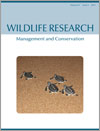Context . Buffel grass (Cenchrus ciliaris L.) is an introduced pasture grass that has spread over large areas of semiarid Australia with potentially significant negative consequences for biodiversity. Previous studies suggest that the response of bird communities to the changes in habitat associated with buffel grass invasion is complex.
Aims . This study compares the behaviour of birds between sub-sites with predominantly native vegetation where buffel grass had been removed and control sub-sites with buffel grass, which were left unmanaged, at two locations in central Australia. Our objective was to evaluate whether removing buffel grass at small scales had measurable benefits for local bird species and to better understand how the presence of buffel grass affects bird behaviour.
Methods . We assessed differences in microhabitat use and behaviour of all species combined and when separated into above ground, flexible and ground foraging guilds. We also tested for direct correlations between different cover types and the microhabitat use and behaviour of birds within guilds, with some further analyses of three common species individually.
Key results . Management of buffel grass was associated with changes in the microhabitat use and behaviour of birds when all species were combined and for all foraging guilds. Buffel grass cover was negatively correlated with the proportional time birds spent on the ground and with proportional time spent foraging. However, of the three species examined individually only the behaviour of white-winged trillers (Lalage tricolor) was consistently correlated with ground vegetation cover. Our observations also suggest birds spent less time overall at sites with high buffel grass.
Conclusions . Managing buffel grass in small areas creates islands of habitat that provide important opportunities for foraging at a localised scale. Buffel grass and other ground cover affects the behaviour of birds collectively, but individual species responses vary.
Implications . Management of buffel grass in small areas with high conservation value should be considered. Our study will help to inform land managers of the benefits of controlling buffel grass on a localised scale.





